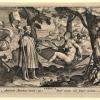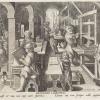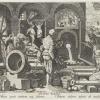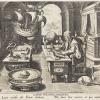Introduction: New inventions, c. 1600
Commentary
... it is well to observe the force and virtue and consequences of discoveries; and these are to be seen nowhere more conspicuously than in those three which were unknown to the ancients, and of which the origin, though recent, is obscure and inglorious; namely, printing, gunpowder, and the magnet[ic compass]. For these three have changed the whole face and state of things throughout the world; the first in literature, the second in warfare, the third in navigation; whence have followed innumerable changes; insomuch that no empire, no sect, no star seems to have exerted greater power and influence in human affairs than these mechanical discoveries.
Francis Bacon, Novum Organum, aphorism CXXIX
Image. The title page of Jan van der Straet's Nova reperta (above) might almost be regarded as an illustration of the famous passage from Bacon's Novum Organum reproduced here below it. The Nova reperta is a series of twenty engravings illustrating ‘new inventions'. 'Nova' in this case is the opposite of 'antiqua': that is to say, these are not 'recent discoveries' in the sense that they have all been found within the last century or two; rather, they are new in the sense that they were unknown in classical antiquity. This series therefore represents graphic evidence of Europeans’ consciousness of living in a new historical era, defined by technological advances on antiquity.
The four inventions pictured most prominently on this title page – America, the magnetic compass, gunpowder, and printing – are also the first four discoveries treated in the series of engravings, and correspond to Bacon's three great discoveries 'unknown to the ancients'. Bacon goes on to indicate that their 'origin, though recent, is obscure and inglorious'. The reason is that they were all invented at the opposite end of Eurasia, in China: in fact, together with paper, they correspond to the 'four great inventions' for which China proudly takes credit today.
The title page also serves as a visual table of contents of the series: the sequence with which the inventions are numbered here (with Roman numerals in the image and Arabic numerals in the legend below) corresponds to the order of the engravings which follow. Also included in the series are further Eastern inventions, such as silk and the astrolabe, and others which we shall consider in this paper, such as the mechanical clock, wind and water mills, lenses, and copper engraving.
Literature: Uta Bernsmeier, ‘Die Nova Reperta des Jan van der Straet : ein Beitrag zur Problemgeschichte der Entdeckungen und Erfindungen im 16. Jahrhundert’ (PhD dissertation, Universität Hamburg, 1986); F W H Hollstein, The New Hollstein: Dutch and Flemish etchings, engravings and woodcuts 1450-1700 (Amsterdam, 1993); Alessandra Baroni Vannucci, Jan van der Straet, detto Giovanni Stradano, flandrus pictor et inventor (Milan, 1997); Susan Dackerman et al.. Prints and the Pursuit of Knowledge in Early Modern Europe (New Haven and London, 2011), cat.no.1; A. Baroni and M. Sellink, Stradanus 1523-1605: Court artist of the Medici [exhibition catalogue, Groeningemuseum Brugge, 2008-2009] (Turnhout, 2012), pp. 300-306, cat. no. 99-107.




